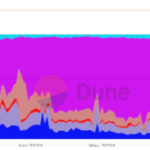Binance, the world’s largest cryptocurrency exchange by trading volume, has lost considerable market share recently. CCData estimates that Binance’s trading volume in the $2 trillion digital asset market declined to 36.6% in September.
This is the lowest the exchange has traded in the last four years, dropping from 42.7% at the beginning of 2023. The decline has been most pronounced in both the spot and the derivatives markets.
Binance’s market share in the spot market fell to 27%, the lowest since January of this year. Likewise, the derivatives market share fell to 40.7%, a market share low not seen in the last four years.
Binance has faced challenges, but the platform has recently marked a significant accomplishment. The exchange became the first centralized cryptocurrency trading platform to hit $100 trillion in trading volume lifetime. This achievement was made while competitors started taking more of the market share.
Binance Faces Market Share Loss Amid Legal Troubles
Binance has lost market share due to its legal issues, which it experiences from time to time. In the last year, Binance has come under pressure from regulators, especially the United States. It peaked when the company had to settle with the US Department of Justice and was fined $4 billion.
The settlement arose from very severe allegations, such as sanctions violations. Furthermore, the co-founder and former CEO of Bit Mex Changpeng Zhao (CZ) was imprisoned for four months. His resignation and the leadership change have affected the company in this year’s turbulence.
Others have seized the opportunity to attract even more people, which could mean Binance is losing its users. Some exchanges include Bybit, Bitget, and Crypto.com, poised to gain market share with similar trading interfaces. More crypto traders are shifting, hoping for lower fees, higher liquidity, and less slippage.
Binance Faces Market Struggles Despite Leadership Change
As a result of these challenges, Binance recently selected Richard Teng as its new CEO. Teng, who used to work as a regulator, has been interacting with the authorities probing Binance’s business in different countries.
This is a strategic appointment at the exchange as it tries to regain lost trust and deal with the intricate legal framework. Teng has also managed the creation of the new board of directors and other organizational changes.
He intends to establish a new headquarters for Binance, which has operated without a fixed base for years. These efforts aim to improve the company’s standing and reassure regulators and users.
The global regulatory landscape for crypto exchanges remains challenging, and Binance is one of many affected. While the broader market for centralized exchanges saw a 17% decline in combined spot and derivatives trading in September, Binance’s drop in market share has been the most pronounced. The company is now focused on stabilizing its operations and recovering lost ground.
Trading Activity Hits Lowest Point Since June
The decline in trading volumes across centralized exchanges is part of a broader market trend. September is historically a weak month for trading activity, and this year was no exception.
Overall trading volume reached its lowest point since June, reflecting broader market concerns and economic uncertainties. Binance’s competitors have been quick to seize opportunities in this shifting landscape. Bybit, Bitget, and Crypto.com have gained traction by offering traders competitive advantages like low fees and better liquidity.
These factors have helped alternative platforms gain confidence among crypto traders, especially as Binance faces mounting legal and regulatory challenges. Despite the hurdles, Binance continues to hold a significant market share, and its recent milestone of $100 trillion in lifetime trading volume reflects its enduring influence.
However, the exchange must address the ongoing challenges to regain its previous market dominance. The coming months will be critical as Binance navigates its legal battles and works to rebuild its leadership team.










